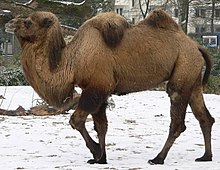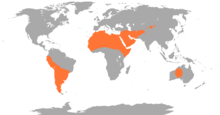Camelid
| Camelids Temporal range: 45–0 Ma Middle Eocene-Holocene |
|
|---|---|
 |
|
| A Bactrian camel walking in the snow | |
| Scientific classification | |
| Kingdom: | Animalia |
| Phylum: | Chordata |
| Clade: | Synapsida |
| Class: | Mammalia |
| Order: | Artiodactyla |
| Superfamily: | Cameloidea |
| Family: |
Camelidae Gray, 1821 |
| Genera | |
 |
|
| Current range of camelids, all species | |
Lama
Vicugna
Camelus
†Paracamelus
†Camelops
Camelids are members of the biological family Camelidae, the only currently living family in the suborder Tylopoda. The extant members of this group are: dromedary camels, Bactrian camels, wild Bactrian camels, llamas, alpacas, vicuñas, and guanacos.
Camelids are even-toed ungulates classified in the order Cetartiodactyla, along with pigs, hippopotamuses, whales, deer, giraffes, cattle, goats, antelope, and many others.
Camelids are large, strictly herbivorous animals with slender necks and long legs. They differ from ruminants in a number of ways. Their dentition show traces of vestigial central incisors in the upper jaw, and the third incisors have developed into canine-like tusks. Camelids also have true canine teeth and tusk-like premolars, which are separated from the molars by a gap. The musculature of the hind limbs differs from those of other ungulates in that the legs are attached to the body only at the top of the thigh, rather than attached by skin and muscle from the knee upwards. Because of this, camelids have to lie down by resting on their knees with their legs tucked underneath their bodies. They have three-chambered stomachs, rather than four-chambered ones; their upper lips are split in two, with each part separately mobile; and, uniquely among mammals, their red blood cells are elliptical. They also have a unique type of antibodies which lack the light chain, in addition to the normal antibodies found in other mammals. These so-called heavy-chain antibodies are being used to develop single-domain antibodies with potential pharmaceutical applications.
...
Wikipedia
